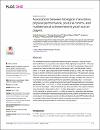Associations between biological maturation, physical performance, postural control, and mathematical achievement in youth soccer players
| Author | Hermassi, Souhail |
| Author | Konukman, Ferman |
| Author | Al-Marri, Senaid Salem |
| Author | Hayes, Lawrence D. |
| Author | Bartels, Thomas |
| Author | Schwesig, René |
| Available date | 2024-09-24T06:10:45Z |
| Publication Date | 2024-03-01 |
| Publication Name | PLoS ONE |
| Identifier | http://dx.doi.org/10.1371/journal.pone.0298301 |
| Citation | Hermassi, S., Konukman, F., Al-Marri, S. S., Hayes, L. D., Bartels, T., & Schwesig, R. (2024). Associations between biological maturation, physical performance, postural control, and mathematical achievement in youth soccer players. Plos one, 19(3), e0298301. |
| Abstract | This investigation explored relationships between biological maturation, physical and academic performance in young male soccer players. Thirty-eight players (age: 9.79 ± 1.21 years; body mass index (BMI): 20.4 ± 2.39 kg/m2; body fat: 16.8 ± 2.21%) participated. Measures of anthropometry used for body mass, body fat percentage (%BF), and BMI as well. Postural control, 15 m sprint, squat jumps and counter-movement jumps (SJ, CMJ), and T-half test for change-of-direction (CoD) were parameters of physical performance. The grade point average (GPA) of mathematics determined academic attainment. Moore’s equations were used to estimate their maturity status (PHV). Biological maturation was highly correlated with most (not 15 m sprint) physical and academic performance parameters, especially CMJ (r = -0.812) and mathematics (r = -0.781). Academic performance showed the largest relations to the jumping performance (CMJ: r = 0.771; SJ: r = 0.723). In contrast, anthropometric and fatness parameters were not relevantly (r ≥ 0.5) correlated with any other parameters. The largest correlations were calculated for sitting height vs. SJ (r = -0.408), sitting height vs. postural control (r = -0.355), leg length vs. postural control (r = -0.339). As a result, it is essential to take biological maturation inconsideration while assessing the physical and academic achievement of young soccer players. In consequence, soccer coaches and physical education (PE) teachers should be cognizant of the impact of biological maturity on physical and academic performance to assist fair and equal opportunities for achievement in young players. |
| Sponsor | The authors would also like to thank the coaches and young soccer players who participated in this study. Special thanks to the students Mohammed Al-Nasser, Mohammed Al-Dosari and Rashid Ahmed Alhajri who have actively contributed to the project with their valuable collaborative effort and for their support during some parts of experiment. |
| Language | en |
| Publisher | Public Library of Science |
| Subject | physical physical performance |
| Type | Article |
| Issue Number | 3 March |
| Issue Number | 3 |
| Volume Number | 19 |
Files in this item
This item appears in the following Collection(s)
-
Physical Education [138 items ]


